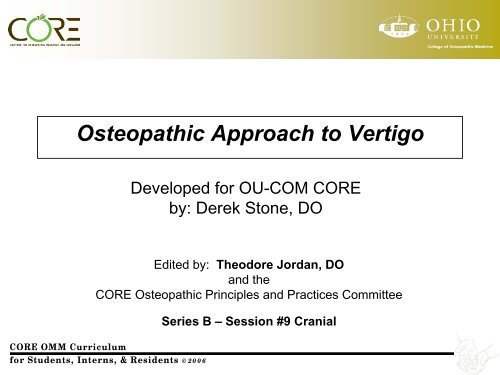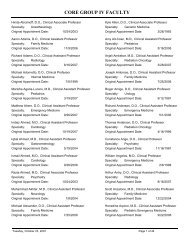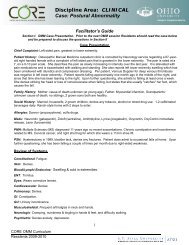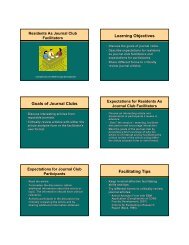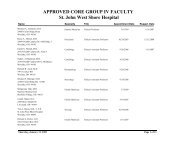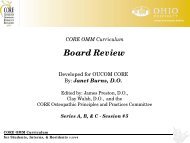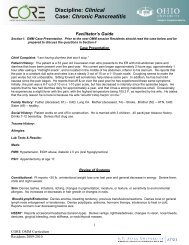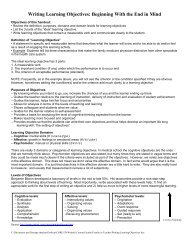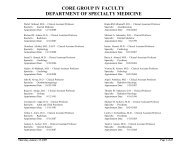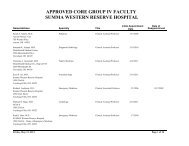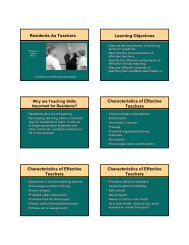Osteopathic Approach to Vertigo
Osteopathic Approach to Vertigo
Osteopathic Approach to Vertigo
You also want an ePaper? Increase the reach of your titles
YUMPU automatically turns print PDFs into web optimized ePapers that Google loves.
<strong>Osteopathic</strong> <strong>Approach</strong> <strong>to</strong> <strong>Vertigo</strong><br />
Developed for OU-COM CORE<br />
by: Derek S<strong>to</strong>ne, DO<br />
Edited by: Theodore Jordan, DO<br />
and the<br />
CORE <strong>Osteopathic</strong> Principles and Practices Committee<br />
CORE OMM Curriculum<br />
for Students, Interns, & Residents ©2006<br />
Series B – Session #9 Cranial
Learning Objectives<br />
• Review signs and symp<strong>to</strong>ms of vertigo<br />
• Discuss somatic dysfunction related <strong>to</strong> vertigo<br />
• Review osteopathic approach <strong>to</strong> cervico-cranial<br />
dysfunction<br />
• Review specific osteopathic techniques for treating<br />
vertigo<br />
CORE OMM Curriculum<br />
for Students, Interns, & Residents ©2006
Clinical Case<br />
CC: 28 y/o with c/o room spinning for 30 min after rolling<br />
over in bed<br />
Hx CC: Started all of a sudden, no his<strong>to</strong>ry of trauma.<br />
• Occurred for two mornings in a row after rolling over in bed.<br />
• Room spinning sensation for 30-45 sec.<br />
• Went away on own.<br />
• Nausea, no vomiting.<br />
• Never had it before, did not really bother him once out of bed.<br />
• No hearing loss or tinnitus with it.<br />
CORE OMM Curriculum<br />
for Students, Interns, & Residents ©2006
Clinical Case<br />
PE: CN II-XII intact. Hearing intact. No nystagmus.<br />
PERRLA. Turbinated clear without discharge. Pharynx<br />
clear. No carotid bruits. + Dix-Hallpike maneuver.<br />
<strong>Osteopathic</strong>: OA FRS left. Increased suboccipital tension.<br />
C4 FRS right. CRI at 12 cycles/min with amplitude of 3/5.<br />
Right temporal internally rotated.<br />
CORE OMM Curriculum<br />
for Students, Interns, & Residents ©2006
Dix-Hallpike<br />
CORE OMM Curriculum<br />
for Students, Interns, & Residents ©2006
Benign Paroxysmal<br />
Positional <strong>Vertigo</strong><br />
• Most common cause of peripheral vertigo<br />
• Theoretically calcium crystals displaced within<br />
semicircular canal<br />
• Episodic vertigo lasting for seconds, associated with<br />
change in head position<br />
• Dx by Dix Hall-Pike test<br />
• Treatment with repositioning exercises, vestibular<br />
suppressants (meclizine), OMT<br />
• Typically self limiting<br />
CORE OMM Curriculum<br />
for Students, Interns, & Residents ©2006
Somatic Dysfunction<br />
common in <strong>Vertigo</strong><br />
• Internal rotation of temporal bone<br />
– CN VIII<br />
• Cranial strain patterns<br />
• Cervical musculature tension<br />
• OA and cervical somatic dysfunction<br />
• T1-T5 somatic dysfunction<br />
– Sympathetic output <strong>to</strong> head and neck<br />
CORE OMM Curriculum<br />
for Students, Interns, & Residents ©2006
<strong>Osteopathic</strong> <strong>Approach</strong> <strong>to</strong><br />
Cranial Dysfunction<br />
– There is articular mobility of the cranial bones<br />
throughout most of life<br />
– Trauma or strain can induce dysfunction in<strong>to</strong> the<br />
cranial bones<br />
– Restrictions or asymmetry in the mobility of the<br />
cranial bones can affect related nerves and their<br />
function<br />
– For instance, asymmetry in temporal bone function<br />
may contribute <strong>to</strong> vertigo<br />
CORE OMM Curriculum<br />
for Students, Interns, & Residents ©2006
OSCE Owl says ...<br />
INTEGRATE:<br />
A.T. Still<br />
Osteopathy<br />
Orthopedic<br />
Neurologic<br />
&<br />
Structural<br />
EXAMS<br />
CORE OMM Curriculum<br />
for Students, Interns, & Residents ©2006
Temporal Bone Ana<strong>to</strong>my<br />
• Temporal bones externally<br />
rotates with craniosacral flexion<br />
• Common dysfunction in<br />
vertigo<br />
• Articulates with sphenoid,<br />
occiput, parietals, zygomas,<br />
and mandible<br />
CORE OMM Curriculum<br />
for Students, Interns, & Residents ©2006<br />
Atlas de Ana<strong>to</strong>mia Humana 1970
Sternocleidomas<strong>to</strong>id<br />
• SCM is a major postural<br />
muscle<br />
• Evaluate the SCM by<br />
palpating for tenderpoints<br />
in the belly and clavicular<br />
attachments<br />
CORE OMM Curriculum<br />
for Students, Interns, & Residents ©2006<br />
Luis Lopez Antunez, 1970
Sternocleidomas<strong>to</strong>id<br />
• SCM Triggerpoints can<br />
radiate pain in<strong>to</strong> forehead,<br />
around eye and behind ear<br />
• SCM dysfunction can also<br />
cause dizziness<br />
CORE OMM Curriculum<br />
for Students, Interns, & Residents ©2006<br />
Travell, J, 1983
Treatment - Case Study<br />
• Pt given meclizine for acute attacks of vertigo<br />
• Repositioning exercises performed in office and taught <strong>to</strong><br />
patient<br />
• OMT provided<br />
– Suboccipital inhibition<br />
– ME <strong>to</strong> cervicals<br />
– Temporal decompression<br />
– Occipital compression (CV4)<br />
CORE OMM Curriculum<br />
for Students, Interns, & Residents ©2006
Lab Techniques - Cranial<br />
• Counterstrain SCM (Jones’ C7 anterior TP)<br />
• Basic evaluation of cranium<br />
• Temporal Decompression<br />
• Parietal Lift<br />
• Cervical ROM stretching, and treatment of any<br />
specific segmental dysfunction<br />
• Occipital compression (CV4)<br />
• V-Spread for OA<br />
• Temporal Rocking<br />
CORE OMM Curriculum<br />
for Students, Interns, & Residents ©2006
Counter-Strain for SCM<br />
• A Common tender point is<br />
at clavicular attachment<br />
(Jones’ Anterior C7 - C8)<br />
• Treatment is cervical<br />
flexion and rotation<br />
• Hold for 90 sec.<br />
• Slowly return <strong>to</strong> neutral<br />
Yates & Glover, 1995.<br />
CORE OMM Curriculum<br />
for Students, Interns, & Residents ©2006
Vault Holds<br />
Evaluate cranial symmetry & motion<br />
CORE OMM Curriculum<br />
for Students, Interns, & Residents ©2006<br />
Essig-Beatty, DR. Pocket Manual of OMT, pgs259&260
Temporal Decompression<br />
• Used <strong>to</strong> correct restricted<br />
temporal bone mobility<br />
• Gently pull earlobes in a<br />
posterolateral direction until<br />
slight give is equal on both<br />
sides<br />
• Recheck<br />
CORE OMM Curriculum<br />
for Students, Interns, & Residents ©2006<br />
Essig-Beatty, DR. Pocket Manual of OMT, pg273
Parietal Lift<br />
• Can be used <strong>to</strong> free up<br />
motion of temporal bone<br />
• Gently contact parietals<br />
superior <strong>to</strong> squamous<br />
suture<br />
• Press medially and gently<br />
lift parietals superiorly until<br />
give is equal on both sides<br />
CORE OMM Curriculum<br />
for Students, Interns, & Residents ©2006<br />
Essig-Beatty, DR. Pocket Manual of OMT, pg269
Cervical ROM - stretching<br />
It can be of great benefit - especially in the elderly<strong>to</strong><br />
take the patient’s cervical spine through<br />
general range of motion; slowly, gently, and with<br />
mild traction:<br />
– Sidebending<br />
– Rotation<br />
– Flexion and segmental extension (careful<br />
whenever inducing cervical extension)<br />
CORE OMM Curriculum<br />
for Students, Interns, & Residents ©2006
Additional useful OMM techniques<br />
CORE OMM Curriculum<br />
for Students, Interns, & Residents ©2006
CV4<br />
• Thenar eminences on occipital<br />
bone medial <strong>to</strong> occipi<strong>to</strong>mas<strong>to</strong>id<br />
sutures<br />
• Palpate cranial flexion and<br />
extension<br />
• Gently encourage extension and<br />
resist flexion until CRI s<strong>to</strong>ps<br />
• Maintain this extension still point<br />
until CRI returns, typically at a<br />
greater amplitude<br />
CORE OMM Curriculum<br />
for Students, Interns, & Residents ©2006<br />
Essig-Beatty, DR. Pocket Manual of OMT, pg267
V-Spread<br />
Occipita-mas<strong>to</strong>id Suture<br />
• Contact bone on either side of suture with index and middle finger and<br />
apply steady traction <strong>to</strong> separate suture<br />
• Place index and middle finger of other hand on opposite side of the head<br />
and exert slight repetitive impulse <strong>to</strong>ward restricted suture<br />
• Continue sutural traction and contralateral impulse until give is finished<br />
CORE OMM Curriculum<br />
for Students, Interns, & Residents ©2006
Temporal Rocking<br />
• One hand exaggerates left<br />
temporal in flexion and the<br />
other hand dampens right<br />
temporal in<strong>to</strong> extension<br />
• The process is reversed<br />
• Can reach a still point<br />
• Return of CRI results in<br />
improved temporal bone<br />
motion<br />
CORE OMM Curriculum<br />
for Students, Interns, & Residents ©2006<br />
Essig-Beatty, DR. Pocket Manual of OMT, pg260
Suboccipital Inhibition<br />
• Hold occiput in palms and<br />
align fingertips inferior <strong>to</strong><br />
inion<br />
• Straighten fingers <strong>to</strong> press<br />
fingertips in<strong>to</strong> muscles<br />
• Hold until relaxation and<br />
head drops in<strong>to</strong> palms<br />
CORE OMM Curriculum<br />
for Students, Interns, & Residents ©2006<br />
Essig-Beatty, DR. Pocket Manual of OMT, pg’226
ME for OA<br />
• Place OA at direct barrier<br />
• Ask patient <strong>to</strong> side bend<br />
gently away from the<br />
restriction against your<br />
resistance for 3-5 seconds<br />
• Repeat 3-5 times, each time<br />
moving <strong>to</strong> new restriction<br />
barrier<br />
CORE OMM Curriculum<br />
for Students, Interns, & Residents ©2006<br />
Essig-Beatty, DR. Pocket Manual of OMT, pg245
Conclusion<br />
• <strong>Vertigo</strong> is a common condition that can be<br />
ameliorated or successfully treated with OMT<br />
• Temporal bone and cervical somatic dysfunction<br />
are commonly implicated<br />
• Knowledge of some basic cranial techniques<br />
can be helpful in treating vertigo<br />
CORE OMM Curriculum<br />
for Students, Interns, & Residents ©2006
References<br />
• Antunez, Luis Lopez. Atlas de Ana<strong>to</strong>mia Humana. 1970.<br />
• Essig-Beatty, DR. Pocket Manual of OMT. Lippincott Williams and<br />
Wilkins, Philadelphia. 2004<br />
• Magoun, Harold Jr. Osteopathy in the Cranial Field. Second Ed.<br />
• Travell, Janet. Myofascial Pain and Dysfunction, Vol.1. Williams &<br />
Wilkins, 1983.<br />
• Wales, Annie. Basic Course in Osteopathy in the Cranial Field. The<br />
Cranial Academy. Rancho Mirage,CA; 2001<br />
• Yates, Herbert, Glover, John. Strain and Counterstrain. Y-Knot<br />
Publishing, 1995.<br />
CORE OMM Curriculum<br />
for Students, Interns, & Residents ©2006


